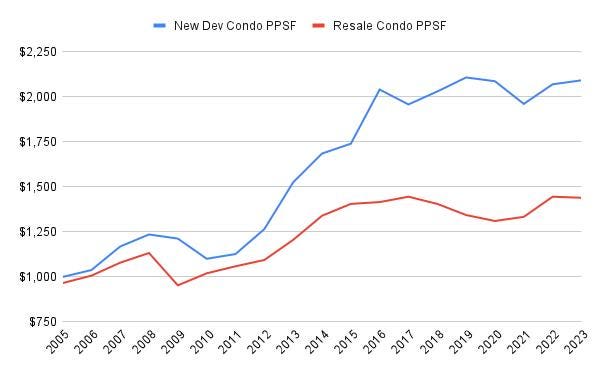When it comes to the Manhattan real estate market, new development condos have traditionally traded at a premium compared to resale buildings. These new condos offer modern amenities, state-of-the-art features, and contemporary designs that cater to buyers seeking a luxurious and convenient lifestyle. However, as buildings age, an interesting phenomenon called “premium decay” emerges, highlighting the diminishing premium associated with aging new development properties as compared to resale ones. In this article, we will delve into the reasons behind this decay and its implications for buyers and sellers in the market.
Why This is Important
The premium attached to new development condos diminishes over time as they age and transition into resale properties. While this doesn’t necessarily lead to a decrease in the overall value of the property, it results in a reduction in the premium attached to the price per square foot when compared to other new developments. This trend is important for buyers to consider when purchasing a new development condo and sellers to take into account when the time comes to sell.
The Rise of the New Dev Premium
Over the last decade, new development condos in Manhattan have become taller, more luxurious, and more expensive. This has led to an increasing spread between new and existing resale units. For example, in 2007, the average price per square foot for a new development condo in Manhattan was $1,168 compared to $1,068 for a resale condo, resulting in a difference of 8%. However, by 2022, the average price per square foot of a new development condo reached $2,070, while resale condos were priced at $1,445 per square foot, resulting in a difference of 43%. The two charts below show the change in price per square foot over time, along with the corresponding increase in premiums commanded by new developments. This widening premium can be attributed to the enhanced features, amenities, and contemporary designs offered by new developments.
Unveiling the Premium Decay Phenomenon
While it’s natural for newer buildings to command a premium due to their modern features and desirability, the phenomenon of premium decay becomes evident as these buildings age. As the chart depicting the price per square foot of aging new development condos shows, the price gradually moves from the initial premium level towards the resale market average. The premium decay follows a step function pattern, with the premium remaining intact for the first five years, then gradually falling behind by 10-15% as the building ages. By the time the building reaches its fifteenth birthday, the premium can decrease by as much as 30%. It’s crucial to note that this decay does not signify a decrease in value, but rather a reduction in the premium associated with new development condos.
Implications for Buyers and Sellers
Buyers considering purchasing a new development condo should be aware of the premium decay phenomenon. While these properties may still appreciate in value, their appreciation trend is unlikely to match that of newer developments. It’s important to recognize that the price trends for new developments are based on the latest buildings only. Therefore, buyers should pay attention to new development trends when making a purchase, but also keep an eye on the overall resale market for a better guide when the time comes to sell. For sellers, understanding the dynamics of premium decay can help set realistic expectations for their unit’s resale value by more closely aligning it with buyers’ expectations.
Conclusion
The allure of new development condos in Manhattan has historically been driven by their modern features, luxury amenities, and contemporary designs. However, as these buildings age, the premium associated with them gradually decays, bringing their price per square foot more in line with the overall resale market. Buyers should be cognizant of this phenomenon when making purchasing decisions, while sellers should temper their expectations regarding future resale premiums. By understanding the dynamics of premium decay, both buyers and sellers can navigate the Manhattan real estate market with a clearer perspective and make more informed decisions.
Read the full article here



